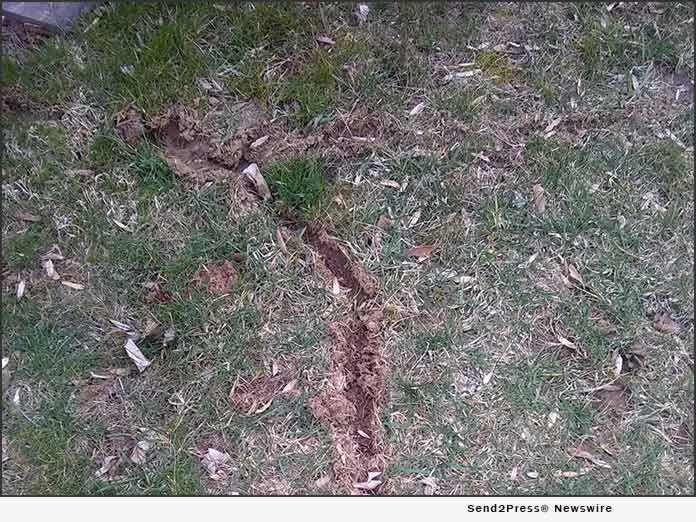HUNTINGDON VALLEY, Pa. /ScoopCloud/ -- Mole and vole damage to lawns, trees and shrubs is common in Pennsylvania, but identifying the difference between the two can be confusing. Each of these two pests can cause mild to serious damage on a homeowners property, and late winter is when the effects are often seen. The experts at Giroud Tree and Lawn explain how to identify the difference between the two and what homeowners can do to reverse the damage.
How to Identify Vole Damage on a Lawn
Voles, otherwise known as "Meadow Mice", are small rodents with very active lifestyles in the winter. They live under dense shrubs and mulch and other hiding places like wood or rock piles. Voles eat grass, and in winter, the snow provides the perfect cover for voles to venture from their burrows in search of food without fear of predators. Homeowners can identify vole damage after snow melts by the telltale chiseled pathways through the lawn. Voles create these runways under the cover of snow where predators can't catch them.
How to Identify Mole Damage on a Lawn
Like voles, moles can do a lot of damage to a lawn. However, rather than pathways carved into the grass at the surface, moles tunnel underground and leave piles of soil that act as air vents in their tunnels.
"If you have a lawn that is really infested with moles, you can actually feel it as you walk across the grass," explains Giroud Lawn Care Technician, Paul Ruffenach. "The ground will feel soft because the tunnels have been dug through under your feet."
Damage to Trees and Shrubs
Although lawn damage caused by voles and moles is very easy to see, what can often go unnoticed until it's too late is damage to trees and shrubs. These invasive little creatures feast on the bark of certain trees and shrubs.
"Both voles and moles will chew on the roots, trunks and branches of some shrubs because they are feeding on the starches and the sugars to stay alive in winter," explains Drew Slousky, ISA Certified Giroud Arborist and Vice President. "If they chew the bark completely off, they could kill a shrub or a tree."
Single stemmed trees like Dogwoods and Crabapples will likely die if voles or moles have girdled the tree by eating the bark completely around the trunk. Multi-stemmed shrubs like Juniper, rhododendron, Viburnum, Euonymous (Burning Bush) and Azalea can survive. Professional pruning or fertilization will help with recovery.
How to Protect a Property from Mole and Vole Damage
Take away hiding spots! Moles and voles burrow under anything that may act as a cover in order to keep out of the watchful eyes of predators. Snow, underbrush and overgrown ground cover are all perfect hiding spots.
As the weather warms, mulch also becomes a great cover for them. Giroud always stresses the importance of never piling mulch against the trunk of a tree or shrubs because it can lead to girdling roots. Garden pests like moles and voles are just another reason why proper mulching is important. Creating a space for these rodents to burrow is an invitation for them to chew on the bark of trees and shrubs!
Check out this video from Giroud Arborist, Rob Nagy, which shows how he identified that a rodent was causing an ornamental holly to decline: https://youtu.be/8Ogfh-Yi6Mk
Take Action Now to Correct Mole and Vole Damage
The good news is most lawns, trees and shrubs will recover from minimal mole or vole damage. For lawns:
* Rake the debris and excrement from the runways on the lawn to promote growth
* Fill holes and pathways with topsoil
* Fertilize and overseed areas that do not recover
Getting on a great lawn care treatment and fertilization program is a step in the right direction because it will strengthen the grass' roots and give the lawn a fighting chance against attacks from mole and vole damage and also other pests, insects and diseases!
If homeowners see signs of pest infestation on trees and shrubs, such as chewed trunks and branches, leaf dieback and discoloration, they should have them inspected by an ISA Certified Arborist who may recommend pruning out the damaged branches. Also, a deep root vitamin fertilizer treatment will strengthen the plant and aid in its recovery.
About Giroud Tree and Lawn
Giroud Tree and Lawn specializes in tree service, lawn care and mosquito and tick control programs that make customers love doing business with the company since 1974. Serving Bucks, Montgomery and Philadelphia Counties, the company offers professional tree and lawn evaluation, tree pruning, tree removal, insect and disease control, fertilizing, stump removal, traditional and 100% organic lawn programs and mosquito and tick control. Giroud Arborists are certified by the International Society of Arboriculture (ISA) and have the knowledge and experience required to properly diagnose, treat and maintain trees and lawn health.
The company is Accredited by the Tree Care Industry Association and Better Business Bureau. The "Giroud Treework for Charity" program donates free tree care services to parks, historical sites and other non-profit organizations located in the Company's service area.
For more information, visit the company website at http://www.giroudtree.com or call 215-682-7704.
VIDEO (YouTube): https://youtu.be/8Ogfh-Yi6Mk

Mole and vole damage to lawns, trees and shrubs is common in Pennsylvania, but identifying the difference between the two can be confusing. Each of these two pests can cause mild to serious damage on a homeowners property, and late winter is when the effects are often seen.
Related link: http://www.giroudtree.com
This version of news story was published on ScoopCloud™ (ScoopCloud.com) - part of and © the Neotrope® News Network - all rights reserved.
